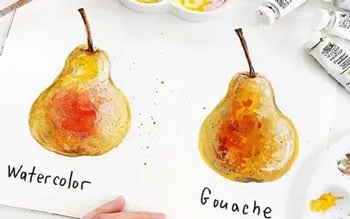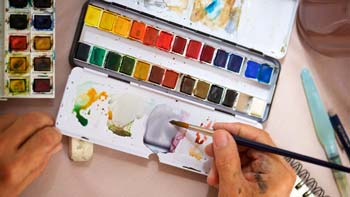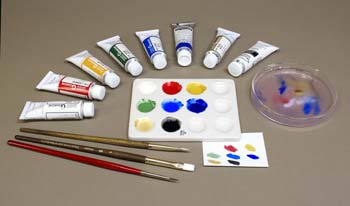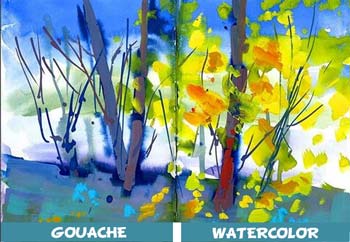
Are you an artist or someone who is getting started but feel clueless when choosing between Watercolor vs Gouache? They both are reliable paints, but they are used differently.
At first sight, they may appear to be similar in some ways. But many differences separate these two paints from one another.
To step up your painting skills, you need to figure out when and why to use them. Here, you will learn the main differences between these two popular paints and some tips to keep in mind when choosing between them.
Gouache Paint and Watercolor Which One Is Better?
Have you ever seen those beautiful paints and wondered if they used watercolor or Gouache to achieve such impressive results?
Each one of these two paints is used differently. Even though they share a lot of features and sometimes provide the same results, they are used separately for different results.
So, let’s go over the differences and find out when to use one over the other and how you could incorporate them into your artwork.
What Is Watercolor?

Watercolor paint is just a painting method made by mixing pigments with water. Watercolor is commonly used on paper. It is excellent for those when you need somewhat transparent paint.
Many people love using watercolor over any other type of paint, as it is incredibly easy to use. I bet you have never heard of anyone ruining their brushes because they used watercolor.
Benefits of Using Watercolor
Watercolor is such a versatile type of paint. There is so much you can do with it. This is the go-to paint when you want to get transparent results. But there is much more than just that.
So, here are the main benefits you get from using watercolor paint. We do a deep dive into watercolor printer in our article to printing on watercolor paper.
Versatility
Wouldn’t it be great if you could get watercolor in many different forms? We have great news for you. Watercolors always come in many different shapes. Pans, tubes, and liquid – they all have different consistencies.
To get the best results with watercolors, you don’t need to be an expert. You just need watercolor paper, brushes, and clean water. Also, you don’t need any special paper or brushes to work with watercolor.
Lighter Results
One of the most noticeable differences between these two paints is that watercolor is not nearly as opaque as Gouache. This is useful for those people that want lighter and vivid results.
Watercolor is water-soluble paint. So, you only need to mix it with water and paint. But depending on how much water you incorporate into your paint, the shade of your color could be a little bit lighter or darker.
Since both paints are water-soluble, they can still be altered even if the paint thoroughly dries.
So, if you ever find yourself in such a situation, you simply need a little bit of water for it to be altered.
Different Techniques
The cool thing about watercolor is that its transparency gives you a lot of room for many different techniques. This is super helpful for those folks that are creative and want to have a slightly more spontaneous feel.
Disadvantages of Using Watercolor
Not everything is flying colors with watercolors. There are specific rules you need to know so you can get the best results.
Slow
When working with watercolors, you need to keep time in mind. Missing by a few minutes could lead to undesired results.
For example, if you want a smooth surface with vivid colors, the wetness of the surface must be even. Otherwise, you will end up with blotchiness or weird textured effects.
Transparent
You also have to keep in mind that watercolor is quite transparent. So, the best way to make it look professional is to start from light to dark.
What this means is that you need to start applying lighter shades first and then move on to the dark ones as you paint.
There Is No Going Back
When you are working with watercolors, you need to be careful. For example, if you mess up using the wrong colors, or you simply did not like the outcome, trying to fix such a mess is quite hard.
While it is true that you can use water to fix any undesired results—you can only lift some of the current paint. So, do not expect to be able to completely fix it.
What Is Gouache?

Gouache paint is an opaque, matte type of paint that can be blended. Many people seem to confuse both watercolor paint and Gouache paint while it is true that sometimes you can use Gouache as watercolor.
Benefits of Using Gouache
Gouache paint is quite mysterious in its own way. And just like Watercolor paint, Gouache paint also has a lot of advantages that make it an excellent choice for many artists.
Easy to Use
Just as with watercolors, Gouache paint can also be found in tubes and pens. To work with Gouache paint, you just need brushes, clean water, and pretty much any paper you have at home.
Superb Flexibility
Gouache paint is also water-soluble. Because of that, you can achieve different opacity just by using a little bit of water.
Gouache vs Watercolor, which one is more versatile?
The most significant difference between these two paints that you will notice right away is that you can go from light to dark and from dark to light. Watercolor, on the other hand, can only go from light to dark.
That is quite useful if you need to keep your shade opaquer and darker. You can also water it down to get a more transparent result.
It means that you can repaint the same areas over and over for better results. And you can also use it on colored paper.
Fast-Drying
Gouache paints dry faster than watercolor. Once it has thoroughly dried, you will notice that the results look flat and matte. So, if you are short on time and need a fast-drying paint, Gouache paint is the way to go.
Disadvantages of Using Gouache
Despite how useful Gouache paint can be, there are some significant drawbacks you must keep in mind when using this paint.
Color Difference
Something to keep in mind when working with Gouache paint is that dark colors tend to lighten, and light colors tend to look darker when they thoroughly dry. To get around that, you need to mix your paint for better results.
Somewhat Fragile
One of the most significant drawbacks for most people is how easy it is for Gouache paint to crack. It can easily break if it is not painted or mounted correctly on reliable support.
So, if you are not careful enough with your Gouache paint, expect to see it crack.
Differences Between Watercolor and Gouache

Both watercolor and gouache are two well-known types of painting. However, there are some significant differences between these two.
Let’s take a look to learn more about these two styles of painting.
Paint Quality
Both watercolor and gouache paints are water-soluble paints. In practice, this means both of these styles of painting can be reactivated by adding water.
However, applying them is a whole different story.
To achieve the best possible results with watercolors, you must use watercolor paper.
As for Gouache paint, you can use watercolor paper or any thick paper you have on hand. Either one will get the job done for you.
Transparency
Many artists choose watercolor over Gouache paint when they want to achieve transparency in their drawings.
But why is it that watercolor is more transparent than Gouache paint? Watercolor is made of small ground pigments. So, when you try to spread it, it gives off a transparent effect.
As for Gouache, it is made of bigger pigments. So, if you try to apply the paint, it will sit on top of the current layer, and it won’t look as transparent as watercolor.
White
When it comes to white, both watercolor and gouache work differently.
For example, with watercolor, if you want white spots on your paint, you need to leave out those spots.
If you tried to apply white paint on it, your paint would turn into gouache. So, if you want to maintain the original white, you need to leave out those spots you want to preserve.
However, Gouache takes a different approach to this. With Gouache, if you want a white area, you don’t need to save the area you want to be white.
You can apply white paint, and it will work just fine.
Glazes
Another big difference between these two is how glazes work.
With watercolor, you can apply as many glazes as you want. However, for this to happen, the current layer must be dry.
With Gouache, this is not possible. If you want that effect, you have to add oil, which makes it harder than it needs to be.
And if you tried to add glazes the same way you would with watercolor, the paint will sit on top of the paper, rather than sinking into the paper.
Frequently Asked Questions
This section aims to answer any doubts you might have regarding these two paints that were not addressed before.
Can you use Gouache as watercolor?
They are used differently depending on what you want to achieve. However, there are a few exceptions where you can use Gouache as watercolors, such as glazing, lifting, and much more.
What is Gouache good for?
Gouache mixes incredibly well with colored pencils. Gouache is also useful when you want to go from light to dark and from dark to light.
Is watercolor suitable for beginners?
Whether you’re a professional artist or a beginner, you will find it rather easy to use. You can do many cool things with it, which makes it an excellent choice for beginners.
How long does Gouache take to dry?
Gouache paint dries rather quickly. It takes about 20 minutes before it thoroughly dries.
How do I fix Gouache?
If you messed up while applying Gouache, or just want to change some things, there is still a way to fix Gouache. You simply have to use a little bit of water on it, so you can reactivate it.
Final Words
As you can see, there are many differences between them. You can use them both in your projects to achieve many different and cool results.
Watercolor vs Gouache, which one should I go for? Gouache paint can sometimes be used as watercolor and still get the same results.
On the other hand, watercolor is not nearly as versatile as Gouache. However, watercolor can be used for many other things that Gouache may not be able to achieve.
Such as; being able to add that transparent colors to your paint and not so opaque colors.